.

Berlin at night: photo by NASA astronaut Kevin Ford taken from the International Space Station using ESA's NightPod camera aid, 8 December 2012 (ESA/NASA)
A pulsating point on a map was all there was left to come home to,
Midnight codes having finally isolated
That which needed to be retained outside the cave
Into abstract pseudo knowledges, color dots
On a computer graphic illustrating how and when
The onslaught of universal electrical illumination
Had scattered trophy wounds of light over the savanna
In a desert once some nomad's unconnected nest --
Who could then know, when the windows once aglow
In the bright hall, the hollow ball of bone,
Began to go out, what the night might yet hold,
In its great wideness, for the anxious watchman --
They glimpsed these wonders as through glass darkly
Before the cave wall slide show history ran out of power.

Berlin at night. The former division between East and West Berlin can be seen. The yellow lights correspond to East Berlin and the greener tones show West Berlin. Over twenty years after the Berlin Wall was dismantled the effects of separating the city can still be seen from space: photo by NASA astronaut André Kuipers taken from the International Space Station taken from the International Space Station using ESA's NightPod camera aid, 5 April 2012 (ESA/NASA)

The Netherlands at night: photo by taken by ESA astronaut André Kuipers from the International Space Station using NASA's NightPod camera aid, 5 April 2012 (ESA/NASA)

Naples and the Bay of Naples at night: photo by taken by ESA astronaut André Kuipers from the International Space Station using NASA's NightPod camera aid, 5 April 2012 (ESA/NASA)

Melbourne at night:
photo by taken by ESA astronaut André Kuipers from the International
Space Station using NASA's NightPod camera aid, 4 April 2012 (ESA/NASA)
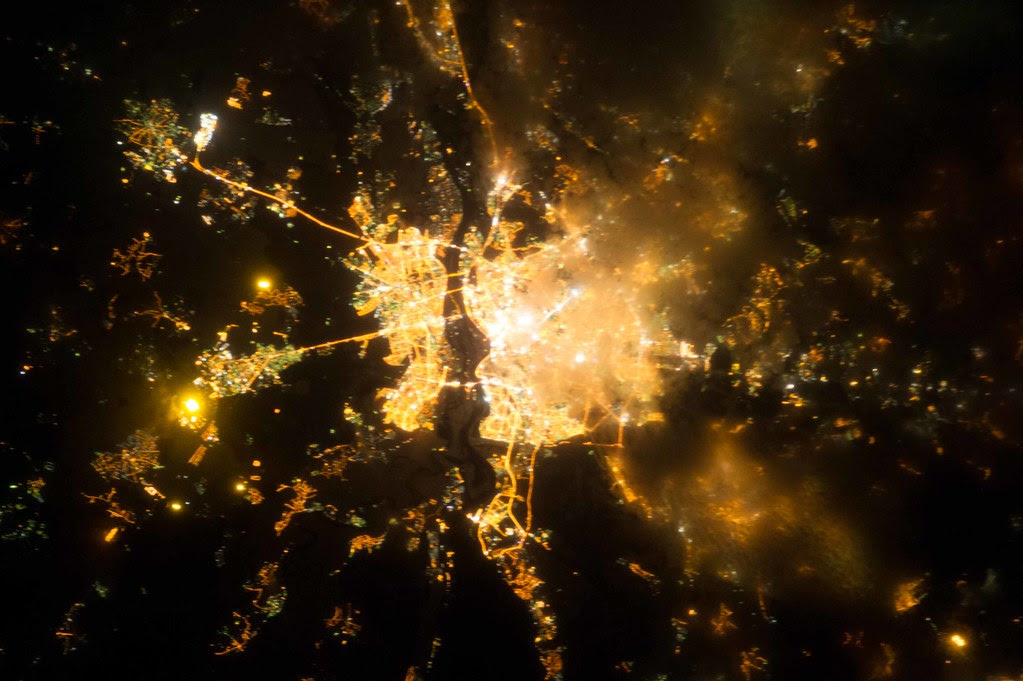
Kiev, Ukraine at night: photo by NASA astronaut Kevin Ford taken from the International Space Station using ESA's NightPod camera aid, 8 December 2012 (ESA/NASA)

Kiev, Ukraine at night: photo by NASA astronaut Kevin Ford taken from the International Space Station using ESA's NightPod camera aid, 8 December 2012 (ESA/NASA)

Cairo at night: photo by NASA astronaut Kevin Ford taken from the International Space Station using ESA's NightPod camera aid, 9 December 2012 (ESA/NASA)

Chinese city at night: photo by NASA astronaut Kevin Ford taken from the International Space Station using ESA's NightPod camera aid, 8 December 2012 (ESA/NASA)

Paris at night: photo taken by ESA astronaut André Kuipers from the International Space Station using NASA's NightPod camera aid, 10 April 2012 (ESA/NASA)
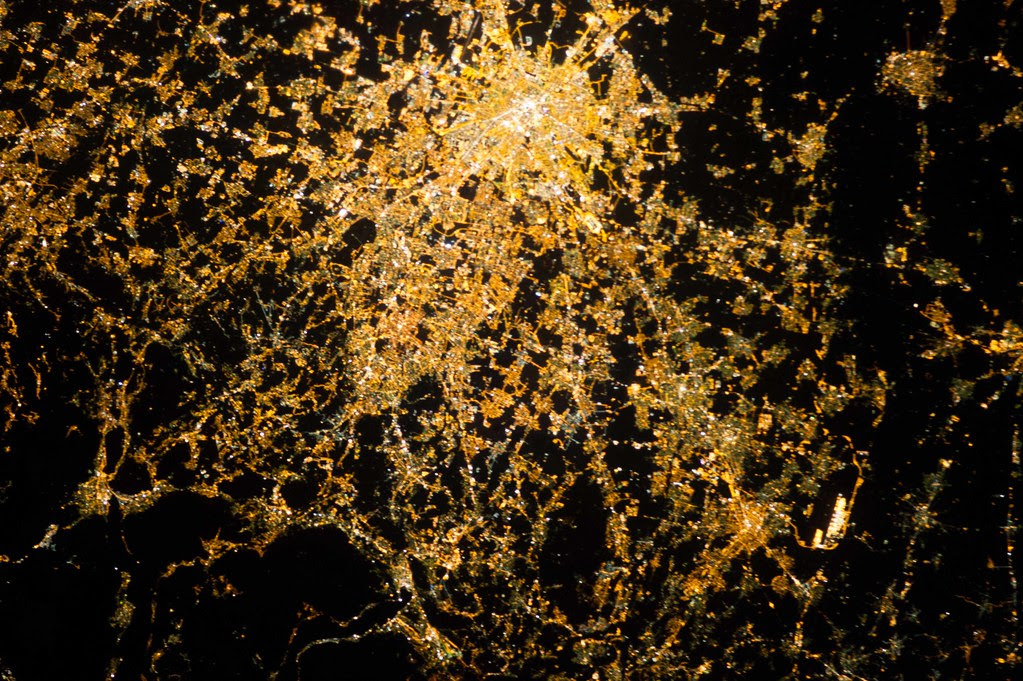
Milan at night: photo by NASA astronaut Kevin Ford taken from the International
Space Station using ESA's NightPod camera aid, 8
December 2012 (ESA/NASA)

London at night: photo by NASA astronaut Kevin Ford taken from the International Space Station using ESA's NightPod camera aid, 9 December 2012 (ESA/NASA)

Nile River Delta at night: satellite photo by ISS Expedition 25 crew, 28 October 2010 (NASA)
(NASA caption: In this view of Egypt, we see a population almost completely concentrated along the Nile Valley, just a small percentage of the country’s land area.The Nile River and its delta look like a brilliant, long-stemmed flower in this astronaut photograph of the south-eastern Mediterranean Sea, as seen from the International Space Station. The Cairo metropolitan area forms a particularly bright base of the flower. The smaller cities and towns within the Nile Delta tend to be hard to see amidst the dense agricultural vegetation during the day. However, these settled areas and the connecting roads between them become clearly visible at night. Likewise, urbanized regions and infrastructure along the Nile River becomes apparent. Another brightly lit region is visible along the eastern coastline of the Mediterranean — the Tel-Aviv metropolitan area in Israel (image right). To the east of Tel-Aviv lies Amman, Jordan. The two major water bodies that define the western and eastern coastlines of the Sinai Peninsula — the Gulf of Suez and the Gulf of Aqaba — are outlined by lights along their coastlines (image lower right). The city lights of Paphos, Limassol, Larnaca and Nicosia are visible on the island of Cyprus (image top). Scattered blue-grey clouds cover the Mediterranean Sea and the Sinai, while much of north-eastern Africa is cloud-free. A thin yellow-brown band tracing the Earth’s curvature at image top is air-glow, a faint band of light emission that results from the interaction of atmospheric atoms and molecules with solar radiation at approximately 100 kilometres altitude.)
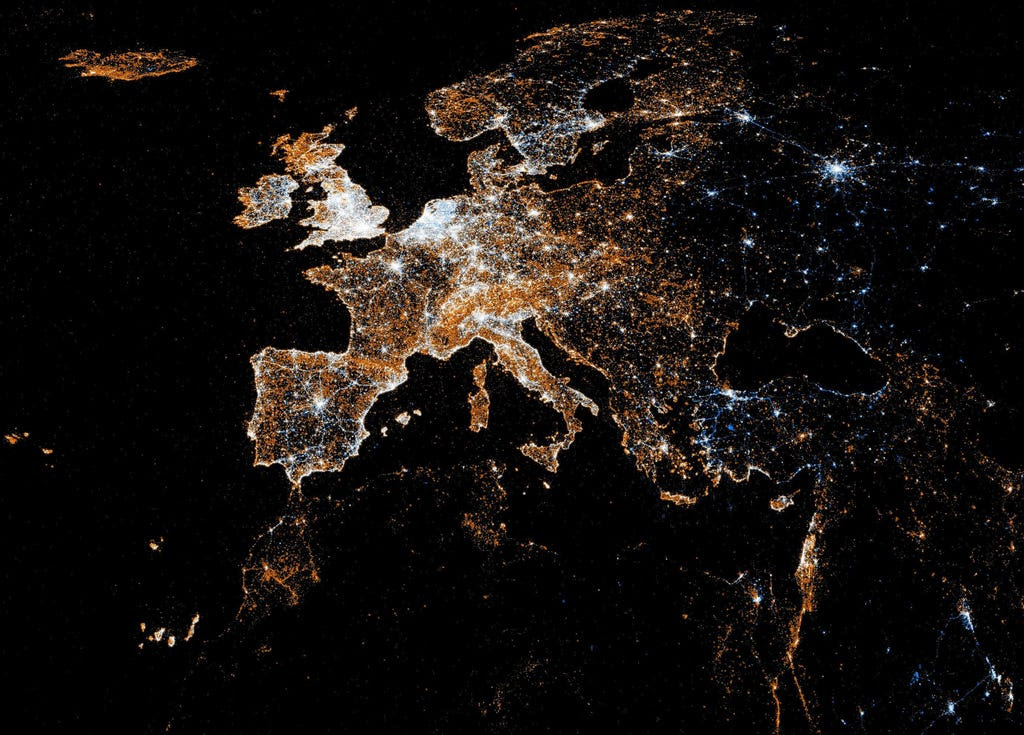
European map of Flickr and Twitter locations. Red dots are locations of Flickr pictures. Blue dots are locations of Twitter tweets. White dots are locations that have been posted to both: image by Eric Fischer (See something or say something), July 2011

London: map of Flickr and Twitter locations. Red dots are locations of Flickr pictures. Blue dots are locations of Twitter tweets. White dots are locations that have been posted to both: image by Eric Fischer (See something or say something), July 2011
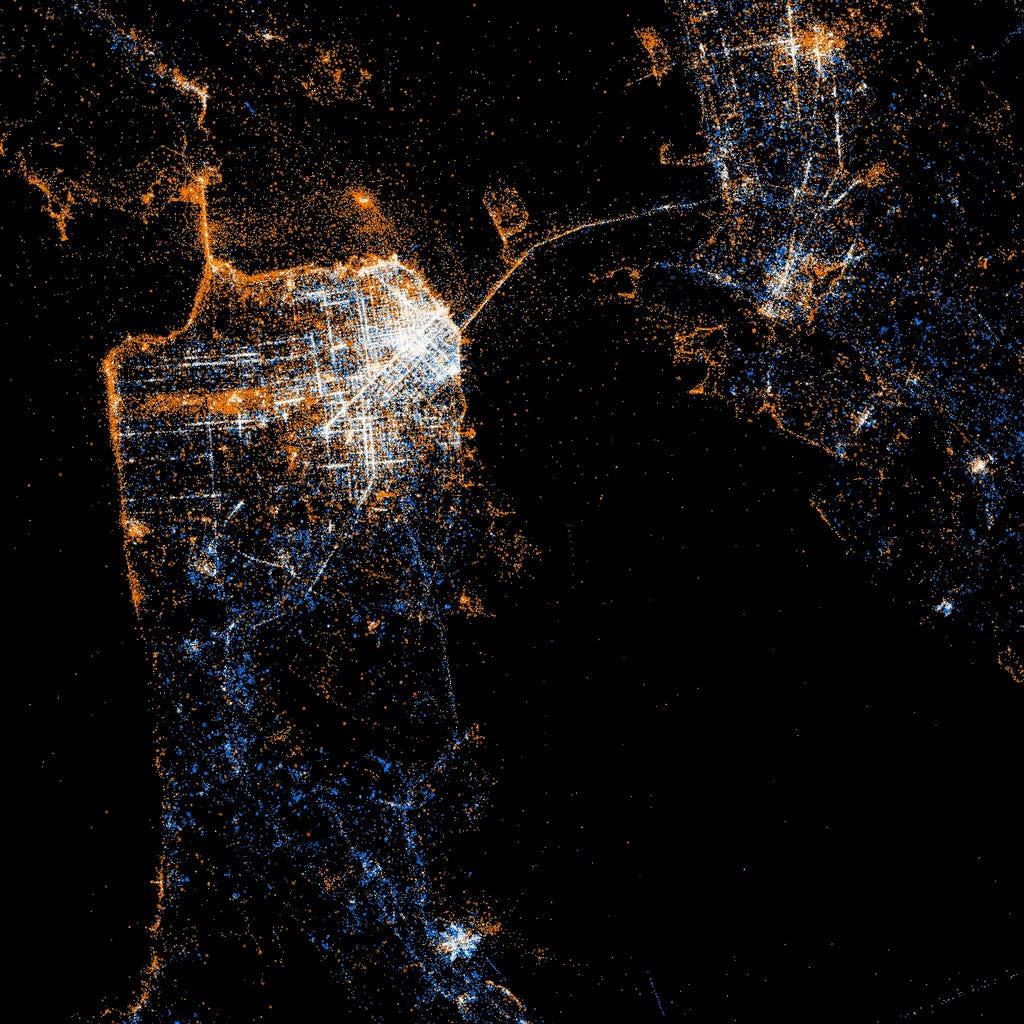
San Francisco: map of Flickr and Twitter locations. Red dots are locations of Flickr pictures. Blue dots are locations of Twitter tweets. White dots are locations that have been posted to both: image by Eric Fischer (See something or say something), July 2011

New York: map of Flickr and Twitter locations. Red dots are locations of
Flickr pictures. Blue dots are locations of Twitter tweets. White dots
are locations that have been posted to both: image by Eric Fischer (See something or say something), July 2011

New York: map of Flickr and Twitter locations. Red dots are locations of
Flickr pictures. Blue dots are locations of Twitter tweets. White dots
are locations that have been posted to both: image by Eric Fischer (See something or say something), July 2011
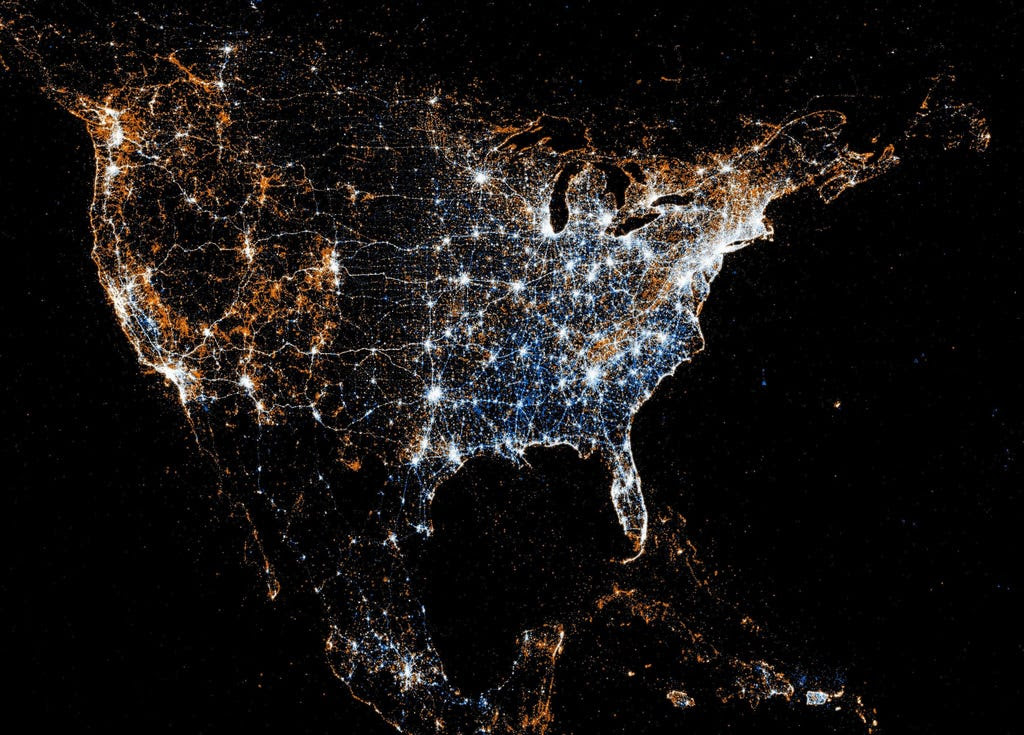
North American map of Flickr and Twitter locations. Red dots are locations of Flickr pictures. Blue dots are locations of Twitter tweets. White dots are locations that have been posted to both: image by Eric Fischer (See something or say something), July 2011
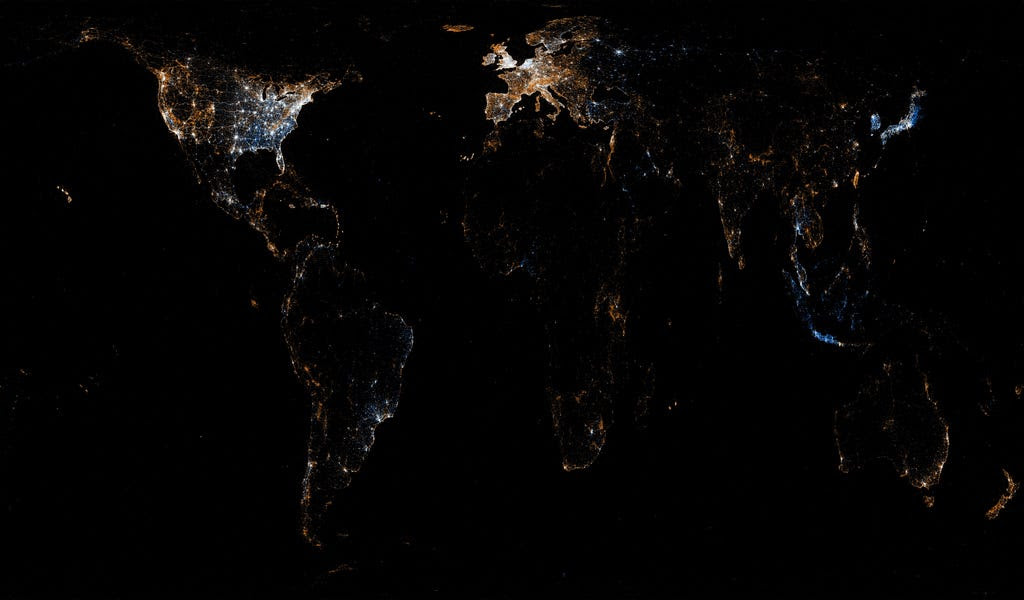
World map of Flickr and Twitter locations. Red dots are locations of Flickr pictures. Blue dots are locations of Twitter tweets. White dots are locations that have been posted to both: image by Eric Fischer (See something or say something), July 2011



6 comments:
I don't know whether to laugh or cry, but I believe I first need to remember to breathe. Waking up to this -- the breathless-making poem and the photo array -- is difficult in the sense that for me, at least, it makes pushing through another day seem at first unappealing or irrelevant. The Flickr/Twitter dots are the least cheerful lights I've ever seen -- they're just enervating. But seeing history written another way in the Berlin photo, which is so unexpected and telling, raises my spirits, and so do the lights of London, Paris, Naples and the Nile Delta. Hollow ball of bone and as through glass darkly really speak to me. Curtis
Yes, I too felt it would have been so much more pleasant had Eric Fischer chosen less horrid colours for the Flickr and Twitter dots.
For a while, before Google withdrew the "personalized iGoogle" homepage (allowing us to opt out of all the available substitute gadgets), we had "summer ocean theme" -- a set of a dozen rotating backdrop scenes, all in various relaxing blue-greens.
That was much nicer.
Still, I think maybe it's the very horrescent hues of the Flickr and Twitter dots that give the images of these swarming metastatic urban lesions their particularly hideous (unintended) impact.
And then too, thinking a bit further on it, maybe, for the imagined audience attending this cave wall slide lecture on history in the Platonic neanderthal Fourth Reich techno millennial future, having relaxing tones for the dots would be "sending the wrong message".
Herd and swarm, often to small purpose with way too much light and noise... it makes one dizzy and blind. More darkness... not more light. More darkness, please.
A couple of years ago, I recall, you posted a BTP entry concerning Twitter that I thought was the last word on the subject. Appropriately, I thought, you used very few words and only a couple of pictures. I had hoped that would end Twitter, but apparently it's just gotten bigger and more important in people's eyes. Acquaintances tell me that I've missed the boat in not seeing its merits and value. But I'm mentally hung up on the phrase "so-called social media" because so many of the applications on offer seem to exist to separate people into their own separate madness cubicles, rather than bringing them together. Eventually, I discontinued my own Facebook account because I couldn't take the poster-wall polemic aspect of it and then being yelled at by "friends" when I would mildly disagree with them or ask a mildly phrased question. At least with Twitter, they can't scream at length, unless of course, it's Cher (who "serial Tweets") and she can do what she likes. Because she's Cher. (As we used to say back at CBS/FOX Video.) Curtis
In that final photo, Europe and the US seem to be faced off, signaling one another with bits of “abstract pseudo knowledges”—whose useful information content probably approaches zero; it certainly isn’t worth the energy expended. Noise, in other words. The picture of the Nile valley all lit up reminded me that human habitation there has always (ever since “civilization” first rolled into town) been clustered in a narrow band along that watercourse.
David Bohm uses the word “endarkenment” to describe all the wrong ideas that pollute the common pool of knowledge, the knowledge base that we humans share. Many of these ideas are just plain bad. They cause harm; they damage us; and they have not-surprising outcomes; pain, confusion, misery; the snafu-world that we all experience.
Here's that Twitter post to which Curtis refers:
Peanuts
On the theme of getting along in the dark:
Artificial Light
And welcoming Hazen back down to the cave:
Endarkenment
Post a Comment